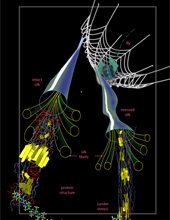While researchers have long known of the incredible strength of
spider silk, the robust nature of the tiny filaments cannot alone
explain how webs survive multiple tears and winds that exceed hurricane
strength.
Now, a study that combines experimental observations of
spider webs with complex computer simulations shows that web durability
depends not only on silk strength, but on how the overall web design
compensates for damage and the response of individual strands to
continuously varying stresses.
Engineered structures are typically designed to withstand large loads
with limited damage, but extreme loads are more difficult to account
for. The spider has uniquely solved this problem by
allowing a sacrificial member to fail under high load. One of the first
questions a structural engineer must ask is ‘What is the design load?'
For a spider web, however, it doesn't matter if the load is just strong
enough to cause failure, or one hundred times higher--the net effect is
the same. Allowing a sacrificial member to fail removes the
unpredictability of 'extreme' loads from the design equation."
For detailed information on NSF-supported research elsewhere in Massachusetts, see results for Massachusetts on Research.gov.
Ref: NSF Press Release 12-016: A Spider Web's Strength Lies in More Than its Silk
*

